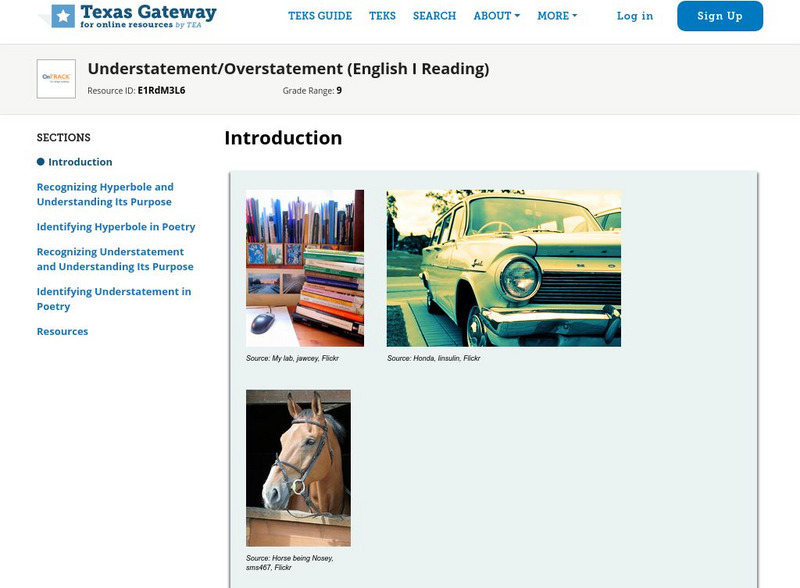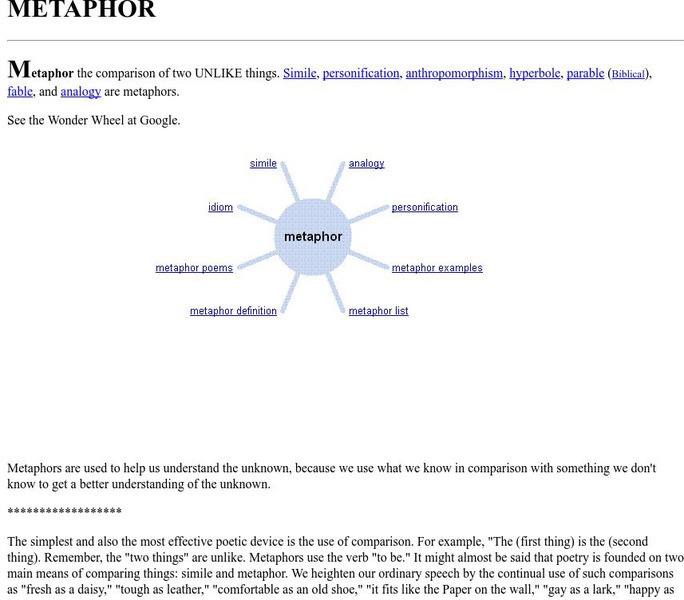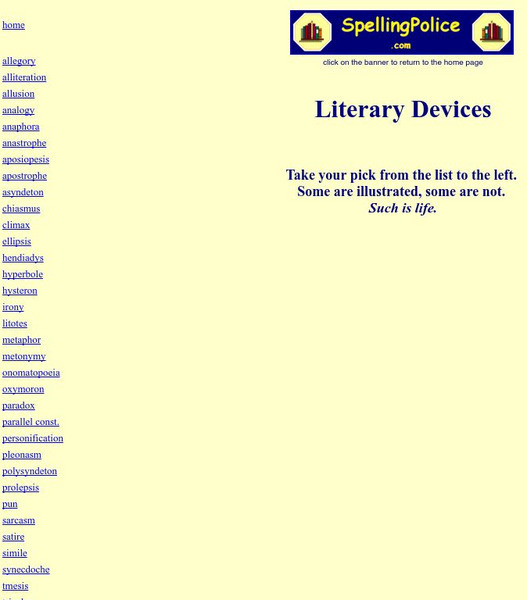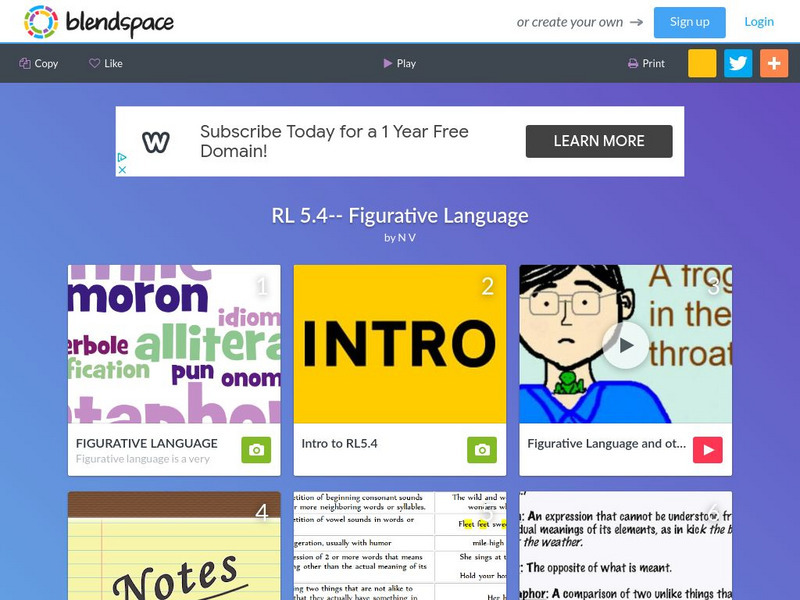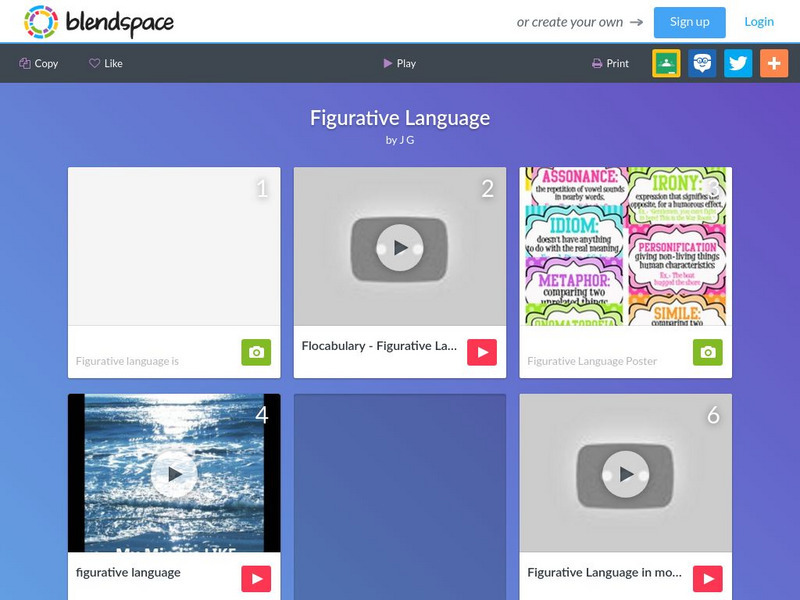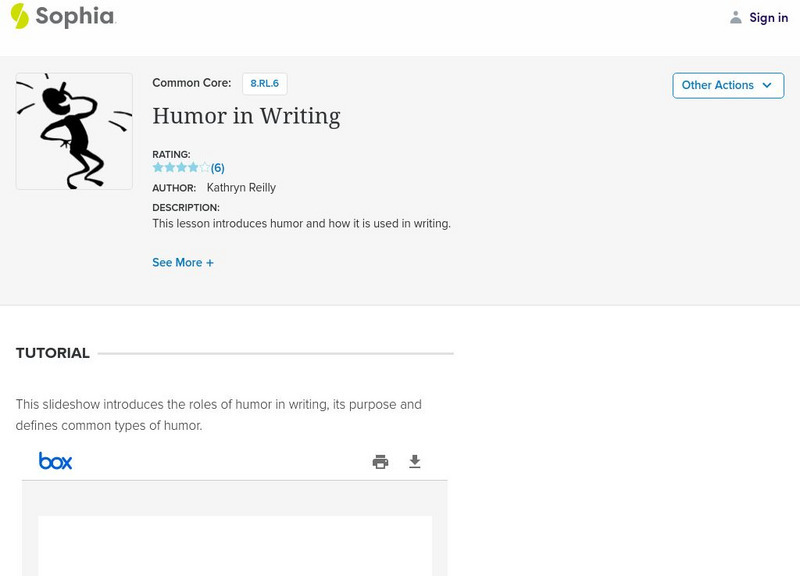Curated OER
Simile, Metaphor, Hyperbole
In this online interactive figurative language instructional activity, students respond to 15 fill in the blank questions identifying each sentence as a simile, metaphor, or hyperbole.
Curated OER
Figurative Language 2
Students read nursery rhymes and advertisements to identify examples of figurative language. As a class, students discuss the use of figurative language and its effectiveness in advertising, children's books, rhymes, poetry, etc. ...
Curated OER
Stretching It
Students recognize the use of exaggeration and understand how it may enhance the story, painting, conversation or event. Students transfer their understanding of exaggeration as it is used in many places, ie., daily life, paintings,...
Curated OER
An Anecdote is Worth a Thousand Pictures
Students identify anecdotes in speeches and the purposes that politicians use the anecdotes for. They create personal anecdotes for the class to hear, and students decide if the anecdote is real or fabricated.
Curated OER
Crazy Critters are Figuratively Fantastic
Eighth graders use creatures created from their imaginations to practice hyperbole, simile, metaphor, and alliteration in association with creative writing. They utilize a worksheet imbedded in this plan to guide their writing.
Curated OER
Figurative Language-Part 1
Students explore figurative language. In this figurative language lesson, students look up, define, and give examples of a list of literary terms.
Curated OER
Short Story 2
Seventh graders review previous reading of Rikki Tikki Tavi. They discuss prior knowledge of simile, metaphor, idiom, and hyperbole. Students practice using vocabulary words from the story by listing synonyms for them. Students read from...
Curated OER
How I Spent My Summer Vacation
Students hear the story How I Spent My Summer Vacation by Wallace Bleef and share their own summer experiences. They write a tale about one event that happened during their summer using exaggeration.
Curated OER
Hyperbole
Students define the term hyperbole and determine when it is appropriate to use hyperboles in writing. They work in pairs to develop short stories and poems with examples of hyperboles.
Georgia Department of Education
Ga Virtual Learning: "Top Twenty Figures of Speech" [Pdf]
This is a two-page PDF of the "Top Twenty Figures of Speech" which provides 20 literary techniques with their definitions from GrammarAbout.com.
Sophia Learning
Sophia: Hyperboles
This tutorial focuses on the use of hyperbole; it defines the term and explains when it is used. It offers two video clips: the first demonstrates the use of hyperbole in song lyrics as it highlights them, and the second shows the use of...
Texas Education Agency
Texas Gateway: Understatement/overstatement (English I Reading)
Students learn about and practice literary techniques including overstatements and understatements.
Huntington Library
Early English Exploration and Settlement of the Colony of Virginia
In this lesson, 5th graders learn about the individuals and groups who first founded the different colonies in America and what their motivations were. Students participate in a reader's theater activity, create a poster that would...
Texas Education Agency
Texas Gateway: Imagery and Figurative Language (Grade 6)
This lesson focuses on the use of imagery and figurative language in writing to aid understanding and create images in the mind.
Texas Education Agency
Texas Gateway: Understatement/overstatement (English I Reading)
A learning module that teaches students to recognize hyperbole and understatement as literary devices in five modules: Introduction, Recognizing Hyperbole and Understanding Its Purpose, Identifying Hyperbole in Poetry, Recognizing...
Ted Nellen
Cyber English (By Ted Nellen): Metaphor
This is a glossary entry for the term "Metaphor" including a definition and links to simile, personification, hyperbole, anology, and other figures of speech.
Other
Spelling police.com: Literary Devices
A simple list of literary terms. Click on each for a definition and examples.
Virtual Salt
Virtual Salt: A Glossary of Literary Terms
This site provides a long list of literary terms complete with full definitions and examples.
TES Global
Blendspace: Rl 5.4 Figurative Language
This twelve-part learning module provides assorted references for figurative language terms. This blendspace provides reproducible charts, flash cards, a game, video tutorial lessons, and rap songs. L.9-10.5 Fig Lang/nuances
E Reading Worksheets
E Reading Worksheets: Figurative Language Poems With Questions
This learning module provides remediation and extra practice with identifying figurative language techniques in the context of poems. Nine different worksheets are available to help reinforce the concept of figurative language in poetry.
E Reading Worksheets
E Reading Worksheets: Figurative Language Examples
Along with definitions for four types of figurative language, this learning module provides numerous examples. Similes, metaphors, personification, and hyperbole are the types of figurative language featured.
TES Global
Blendspace: Figurative Language
A twelve-part learning module on figurative language including links to images, videos, a song, and a game to help students learn.
E Reading Worksheets
E Reading Worksheets: Figurative Language: Reading Test 3
A ten-question quiz on recognizing similes, metaphors, hyperbole, and personification. Results can be printed, saved, or emailed.
Sophia Learning
Sophia: Humor in Writing
Eight slides introducing different types of humor in writing including irony, caricature, satire, wit, blunders, hyperbole, jokes, practical jokes, and puns.


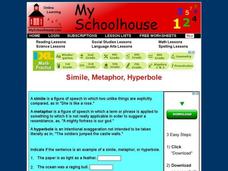



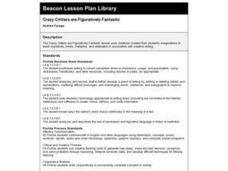




![Ga Virtual Learning: "Top Twenty Figures of Speech" [Pdf] Unit Plan Ga Virtual Learning: "Top Twenty Figures of Speech" [Pdf] Unit Plan](https://d15y2dacu3jp90.cloudfront.net/images/attachment_defaults/resource/large/FPO-knovation.png)

